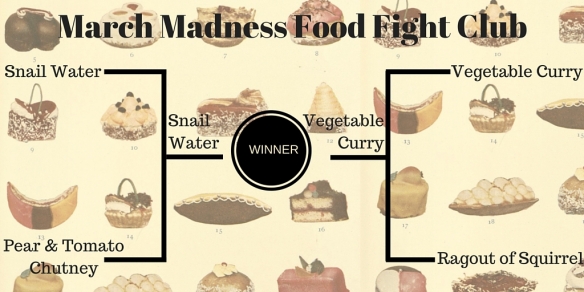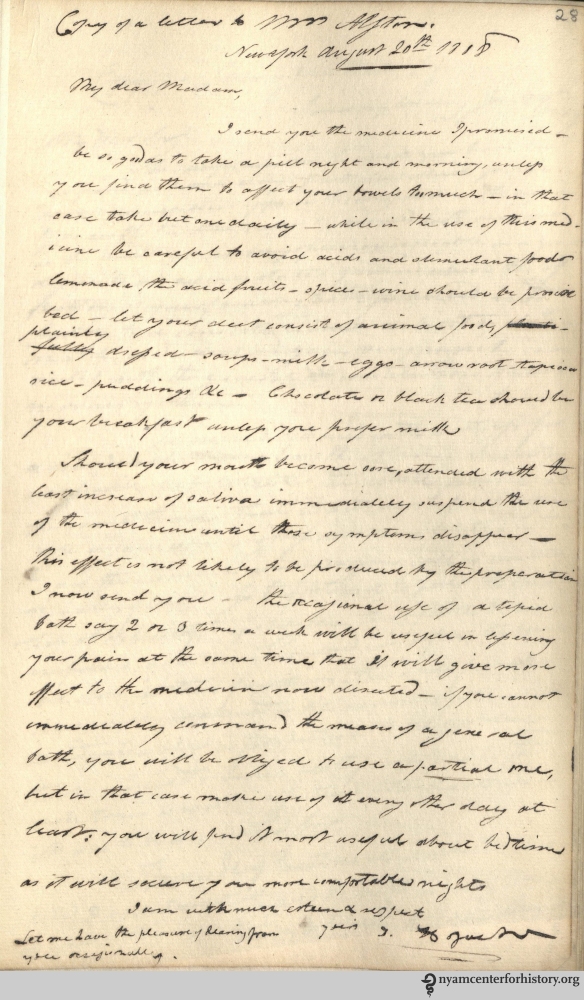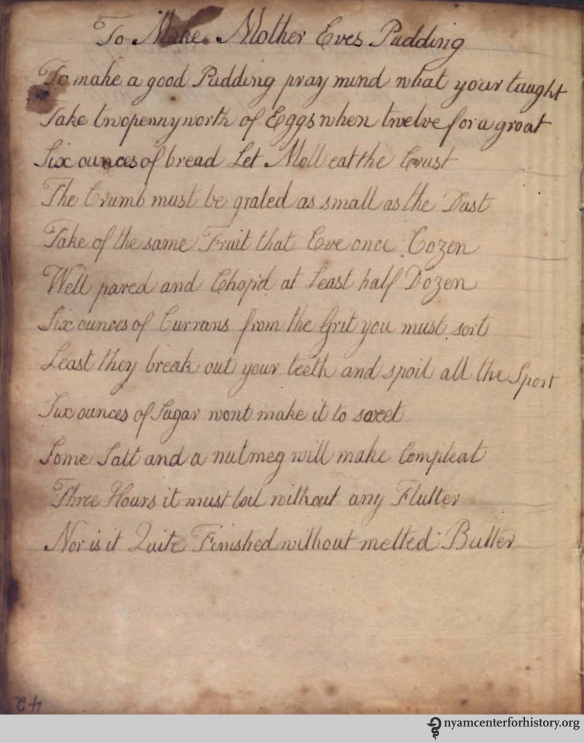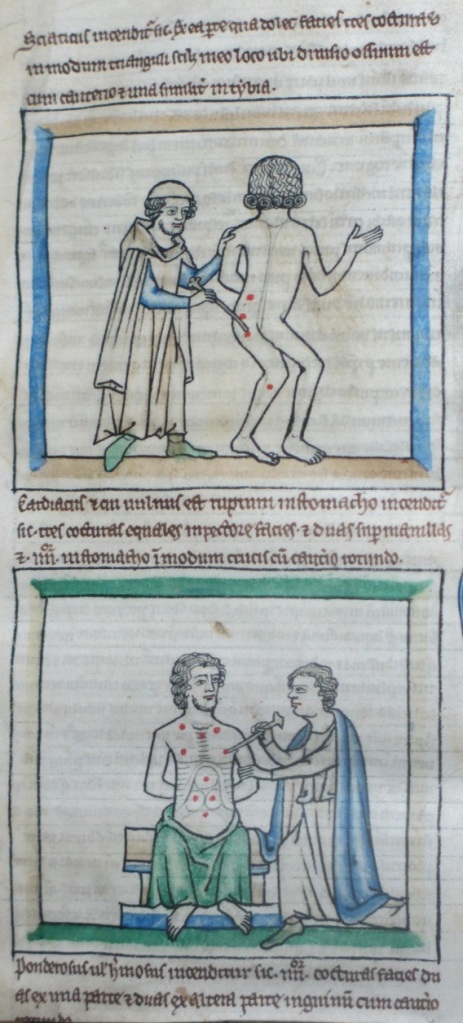By Stephen Schmidt, Manuscript Cookbooks Survey
Over the course of a decade, culinary historian Stephen Schmidt has advised the NYAM Library on our extensive manuscript cookbook collection. This blog post is a version of the essay he wrote about our digital collection Remedies and Recipes: Manuscript Cookbooks. As part of Bibliography Week 2021, he is speaking on “Manuscript Cookbooks and Their Audience” on January 30.
Introduction to Manuscript Cookbooks
The modern Anglo-American tradition of manuscript cookbooks might be said to begin with the world’s first printed cookbook, De honesta voluptate et valetudine, or “On right pleasure and good health.” Written by the celebrated humanist writer Bartolomeo Sacchi, known as Platina, and first published around 1474, the book was translated into Italian, French, and German within a few decades of publication, and it remained widely read throughout Europe into the early eighteenth century. The book featured both a new cuisine and, just as importantly, a new attitude toward food and cooking. Platina presented an interest in food and its preparation as a kind of connoisseurship akin to the connoisseurship of painting, music, or literature. Europe came to call Platina’s attitude toward food and cooking “epicurean,” and those who espoused it “epicures.” At the dawn of the sixteenth century, these new individuals were emblematic of the Renaissance European world.

When Italian epicureanism was first unleashed in Europe, England was in the throes of its own cultural and intellectual Renaissance. Among the English elite classes, the quest for new knowledge found expression in the collecting and creating of recipes, known then and well into the nineteenth century by the now-archaic word “receipts.” Originally the word receipt meant a prescription for a medicine or remedy. During the Renaissance, as the knowledge-hungry English began to write and collect prescription-like formulas for all sorts of things, the term receipt broadened accordingly: directions for farming and building; formulas for chemistry and alchemy; recipes for practical household products like cleaning solutions and paints, and, amid the growing epicurean spirt of the time, food recipes. The sixteenth-century English made a distinction between receipts pertaining to the home and commonly undertaken by women, and receipts for things involving work outside the home, assumed to be the concern of men. Thus, most who collected food and drink recipes also collected receipts for medicines, remedies, cosmetics, and household necessities such as candles, cleaners, pesticides, fabric dyes, and ink. Today, these books of mixed home recipes are often referred to as “cookbooks” when a substantial portion of their recipes concern food and drink.
Cookbooks in History—Manuscript and Print
There is a persistent belief that in the early modern world recipes originated in the home and then were subsequently picked up in print cookbooks. In fact, this was true in England only during the Renaissance, that is, up to about 1625. Only about a dozen cookbooks were published in England, from the first, in 1500, to that date. This may have been due to a lack of demand, but it was also surely due to the thorny practical problem that, cookbooks being a new idea, a community of writers possessing the specialized skills needed to produce them had yet to develop. Printers solved this problem in the only way they could: by cobbling together their printed cookbooks from manuscript cookbooks compiled by ladies of the peerage and then slapping titles and, in some instances, putative authors on them, all of whom, of course, were men. In most instances, the women who actually wrote these cookbooks were unacknowledged—some of their manuscripts may well have been pilfered from their estates—although two Renaissance cookbook authors, John Partridge and Gervase Markham, did explicitly credit noble ladies as the true originators of their printed books. While manuscript cookbooks preceded print cookbooks during the English Renaissance, this situation was soon to change.

During the seventeenth century, the number of published cookbooks grew rapidly in England, as did the number of manuscript cookbooks, to judge from those now extant. As the use of printed cookbooks spread, most recipes in manuscript cookbooks cycled through print at some point. In fact, quite a few manuscript cookbooks compiled after the mid-seventeenth century contain recipes copied verbatim from print. As English cookbook publishing matured, female cookbook authors appeared, starting with the remarkable Hannah Woolley, active in the 1650s through the early 1670s. In the eighteenth and nineteenth centuries, female cookbook authors, who generally branded themselves “experienced housekeepers” rather than professional cooks, dominated English and American cookbook publishing. The relationship between manuscript and print, however, remained the same: recipes cycled from print into manuscript and back into print again, until cooking fashions changed and the old recipes were replaced by new ones.
The NYAM Collection
The eleven NYAM receipt books in Recipes and Remedies show the same organization patterns common to most manuscript books in the English-language tradition. For example, in most of the NYAM books, the culinary recipes are separated from the medical and household recipes in some fashion. In some of the NYAM books, recipes are clustered by subject matter, that is, a clutch of food recipes will be followed by a clutch of medical recipes, and so on. In other NYAM manuscript cookbooks, the culinary recipes are written from the front of the notebook while the medical and household recipes are written from the back of the notebook going toward the center. In one item in the NYAM collection, the medical and household recipes are also written upside down in relation to the culinary recipes, making the separation more explicit.

The Hoffman cook book in the NYAM collection is rare in that it unveils a style of cooking outside the mainstream norm. Written in halting English by a German immigrant to America, this highly interesting cookbook is composed primarily of German-inflected recipes like those we today associate with the so-called Pennsylvania Dutch. It also contains recipes for standard American dishes, such as roast turkey, pumpkin pie, and pound cake, but approached in idiosyncratic ways by a woman struggling to interpret a cuisine that was foreign to her. While the author of this cookbook was a cultural and linguistic outsider and her cooking outside the contemporaneous American mainstream, she was also a woman of privilege, a member of a prosperous German-American family that had owned paper mills in Maryland since the eighteenth century. For these reasons she was the sort of person, whether in Germany or America, who would be expected to use recipes and perhaps also to collect them.
Manuscript cookbook authors tended primarily to collect recipes for fruit preserves, fruit and flower wines, sweet dishes, cakes, and, after 1700, breads and cakes served at breakfast or with tea. About half of the manuscript cookbooks in the NYAM collection reflect the typical manuscript preference for sweets. Most of the culinary and drink recipes in Gemel book of recipes and A collection of choise receipts are geared to banqueting, an extravagant repast of sweets that was sometimes served after important meals and sometimes staged as a stand-alone party during the sixteenth and seventeenth centuries. Recipe book, 1700s titles its culinary section “Wines, Sweetmeats, & Cookery”; recipes in the first two categories far outnumber those in the last. Receipt book, 1848–circa 1885, by an American woman named Jane Beck, can be aptly described as a cake cookbook. This inclination can be explained, in part, by the fact that many ladies personally participated in preserve-making, distilling, and baking, while relegating the preparation of the principal dishes of dinner entirely to their cooks. In addition, the success of sweet dishes and cakes hinges on precise recipes, while savory dishes can be successfully executed intuitively, without recipes, at least by good cooks, or so people seem to have believed. Finally, up through the nineteenth century, the biggest per capita consumers of sugar in the world were the British, with the Americans not far behind.

Conclusion
Manuscript cookbooks contain insights that historical printed cookbooks lack. Manuscript recipes are likely to have been cooked from, if not by the person who collected the recipe and wrote it down in her book, at least by the person from whom the recipe was collected. Thus manuscript cookbooks contain concrete details that historical printed cookbooks generally lack: the precise motion of the hand in stirring; the most suitable cuts of meat; the time that a cooking process takes; the signs that something is going wrong; the size and number of molds needed for individual cakes; the clues that a dish is done; and so on. Manuscript recipes not only illuminate the making of specific dishes but also basic kitchen conditions and broad practices in historical cooking.
A special feature of manuscript cookbooks is that they reflect the tastes of individual households. Thus, while most printed cookbooks published between 1675 and 1800 outline the same three basic recipes for lemon cream, contemporaneous manuscript cookbooks present dozens of different recipes for this favorite dessert, some tart and others sweet, some rich and others lean, suiting the varied tastes of the epicures of centuries past.














































